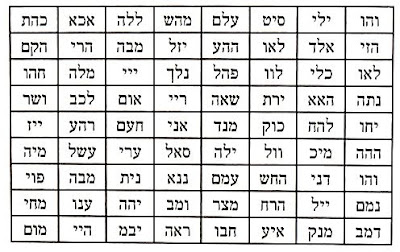Parshas Beshalach
Exodus 13:17-17:16
The three consecutive verses from Exodus 14:19-21 each contain 72 letters, an obviously rare phenomenon. The letters of these three verses can be arranged as 72 triplets of letters. But we are taught in Kabbala that if we reverse the order of the letters in the middle set, the 72 triplets become 72 "names" of G‑d.
In the story of the exodus from Egypt, three consecutive verses describe G‑d's power as manifest just before He split the Sea of Reeds, which the Jewish people passed through on dry land while the Egyptians were drowned:
"And the angel of G‑d who had been going ahead of the camp of Israel now moved and went behind them, and the pillar of cloud went from in front of them and stood behind them. Thus [the pillar of cloud] came between the camp of Egypt and the camp of Israel, making it cloud and darkness [to the Egyptians], but it gave light by night [to the Jews], so that the one came not near the other all the night. Then Moses stretched out his hand over the sea, and G‑d drove the sea back with a strong east wind all that night, and made the sea dry land; thus the waters were divided." (Ex. 14:14)
A name is a means by which one is made known to others.
In Hebrew, these three verses each contain 72 letters. In the Zohar (II:51b) it is stated that these three verses refer in sequence to the divine attributes of chesed, gevura, and tiferet. The harmonious blending of these three principle emotive attributes forms the basic paradigm of how G‑d relates to the world. Thus, they together form a composite name of G‑d, since a name is a means by which one is made known to others, i.e. manifests his attributes.
The fact that each verse contains 72 letters means that they can be aligned in parallel, forming 72 triplets of letters. In this configuration, the Zohar states, the first verse is to be written in its proper order, since it represents G‑d's loving-kindness, or a direct revelation of G‑d's goodness. The second verse is to be written in reverse order, from the last letter to the first, since it represents G‑d's severity, which is an indirect revelation of His goodness. Although tiferet is a blend of both chesed and gevura, the third verse is not to be written half in the proper order and half in reverse order, as one might expect.
There are two reasons for this: (1) in tiferet, chesed dominates over gevura, and (2) as the ideal blend of chesed and gevura, tiferet is a direct revelation of G‑d's goodness and glory rather than an indirect one.
(This array may be seen inter alia in the standard editions of the Zohar, volume 2, p. 270a.)
Source: Chabad


No comments:
Post a Comment